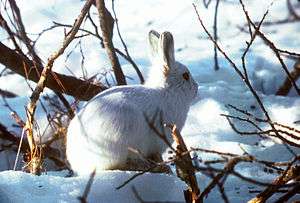Prey detection
Prey detection is the process by which predators are able to detect and locate their prey via sensory signals. This article treats predation in its broadest sense, i.e. where one organism eats another.
Evolutionary struggle and prey defenses

Predators are in an evolutionary arms race with their prey, for which advantageous mutations are constantly preserved by natural selection. In turn, predators too are subject to such selective pressure, those most successful in locating prey passing on their genes in greater number to the next generation's gene pool. Adaptations of prey that allow them to avoid predators are widespread, those that make them hard to find being collectively known as crypsis. Crypsis may involve temporal evasion such as nocturnality, behavioral methods such as hiding, and non-behavioral adaptations such as camouflage. Antipredator adaptations include methods other than crypsis, such as aposematism and the ability to fight.
Often behavioral and passive characteristics are combined, for example a prey animal may look similar to and behave like its hunter's own predator (see mimicry).
Prey detection using different senses
There are a variety of methods used to detect prey. Sensory systems used include the visual system, olfactory system (smell), auditory system (hearing) and the somatosensory system (such as touch). Some predators may use all of these senses in pinpointing their prey, while others may depend mainly or entirely on a single one. Detection methods may also be divided into direct detection of the prey organism itself, and indirect clues, such as the smell of its urine.
Visual

Visual predators may form what is termed a search image of certain prey.
Predators need not locate their host directly: Kestrels for instance are able to detect the faeces and urine of their prey (which reflect ultraviolet), allowing them to identify areas where there are large numbers of voles, for example. This adaptation is essential in prey detection, as voles are quick to hide from such predators.[1]
Chemical
For many animals the chemical senses are far more important than vision or hearing. Some specialist predatory beetle(s) can locate their bark beetle prey using the pheromones their targets secrete. Pheromones that are exploited by an enemy like this are called kairomones.[2]
Auditory
Some predators rely mainly on sound cues to detect prey. In nocturnal predators non-visual clues are especially important. The barn owl (Tyto alba) relies on noises made by prey, and has can locate prey animals with great precision. Bats have the added capability of echolocation to locate prey like flying insects; they can therefore locate prey even if they make no sound.[3]
Following detection
Once a predator has found its prey it will not always attempt to chase or eat it. Prey have other ways of deterring predators from eating them besides avoiding detection. Aposematic plants and animals may have conspicuous coloration such that potential consumer such as a herbivore will avoid eating them based on unpleasant past experiences. Even if a predator may wish to eat its prey, locomotive animals may be extremely difficult to catch.
Animals living in groups have increased vigilance, and even solitary animals are capable of rapid escape when needed. Even if it does make a capture, its prey may attract competing predators, giving it a chance to escape in the struggle. It may also strike a non-vital organ: some species have deceptive appearances such that one part of their body resembles another, such as insects with false heads. This makes consumption (or fatal wound)s less probable, giving the prey a second chance at escaping.
Predators may have extensive capabilities in finding prey, but even when they are successful in doing so they may not end up with a meal.
See also
References
- Alcock, J. (1998) Animal Behavior: An Evolutionary Approach (6th edition), Chapter 10. Sinauer Associates, Inc. Sunderland, Massachusetts. ISBN 0-87893-009-4
Notes
- ↑ Viitala, J., E. Korpimäki, Polakangas, P., Koivula, M. (1995) Attraction of kestrels to vole scent marks visible in ultraviolet light. Nature 373:423-425
- ↑ Wyatt, Tristram D. (2003). Pheromones and Animal Behaviour. Cambridge: Cambridge University Press. p. 2. ISBN 0-521-48526-6.
- ↑ Moiseff, A. and Haresign, T. (2001) Prey Detection by Bats and Owls. Encyclopedia of Life Sciences. DOI: 10.1038/npg.els.0000096